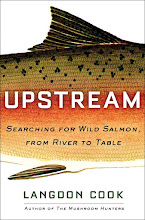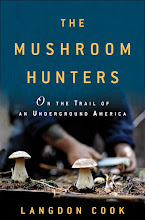Ever eaten mushroom cookies? Nah, not
that kind. These cookies will only give you a sugar high.
This is a post I meant to write more than a year ago, after making a
trip to Mendocino at the end of November, just as the California mushroom season was hitting its stride and Washington State was nodding off for the season. Here we are little more than a year later in the same place: my home turf is only putting out a few
yellowfoot chanterelles (I found some on a walk the other day, which went well with the Christmas stuffing), while to the south you might get into some late
matsutake,
hedgehogs, and that headliner of winter mushrooms, the
black trumpet. Another coastal species to keep an eye out for: the candy cap.
Candy caps (
Lactarius rubidus) are smallish gilled mushrooms that bleed a latex-like fluid when cut, a characteristic of the
Lactarius genus. In the case of candy caps, the fluid is only slightly lactic, with a thin, watery skim milk consistency. The mushrooms are generally orangish to cinnamon-colored and hollow-stemmed—not exactly useful identifiers for West Coast species of
Lactarius, since there are many that fit this bill, most of which you wouldn't want to eat. The best field mark I've come across involves touch. Run a finger over the pileus of a candy cap and feel a cool, slightly bumpy texture, not unlike a tangerine peel. The sweet smell is another characteristic, though not diagnostic.
I've never seen candy caps in Washington. Their strike zone seems to be the coastal mixed forests of Northern California, where I've found them among redwoods and Douglas-fir interspersed with oaks and madrones, usually in damp areas with lots of moss and decaying wood, often near forest edges, trails, and road cuts. In Mendocino, with my friend
Sinclair Philip, who took the photo at left, I found good quantities fruiting near a stream in open, park-like woods behind a regional hospital.
Mushrooms, with their deep
umami, are generally thought of in terms of savory dishes. A few species, notably those in the
Cantharellaceae family such as
chanterelles and black trumpets, exude a hint of stone fruit that is unusual in the fungal kingdom, but only rarely do mushrooms land on the dessert menu. The candy cap, as its common name suggests, is a break from this tradition. Its singular culinary attribute is most obvious after the mushroom has been dried: an aroma redolent of maple syrup.
I found enough candy caps on my 2010 trip to play around in the kitchen, but it was Nate Segraves at the
Fungus Federation of Santa Cruz who kindly set me up with a mason jar full of dried candy caps to do some serious experimentation. For the usual reasons, that experimentation didn't find a vent until this past week. My first attempt was a simple cookie recipe from David Arora's
All that the Rain Promises, a classic way to use candy caps (recipe below).
I've also enjoyed the candy cap in a martini served by chef Chris Czarnecki at the
Joel Palmer House while dining with his father,
Jack. And I plan to use my candy cap stock to make a sauce at some point soon, maybe with slow-cooked pork shoulder. A quick word to the wise, though: my own experience suggests that you should try to use your dried candy caps within a year; unlike dried morels or porcini, which only get better with age, candy caps seem to lose some of their maple syrupy kick over time.
Back to the confections. This is a basic refrigerator cookie recipe that's goosed with candy caps—a good way to showcase the unusual flavor of the mushrooms. Share these with your friends and then casually mention, after they've tucked into a few, that the star ingredient is fungi.
1 cup dried candy cap mushrooms
1 cup butter, softened, plus extra for sauté
1 cup sugar
1 egg
1/2 tsp vanilla
2 1/2 cups flour, sifted
1/2 cup toasted pecans, chopped
1. Rehydrate dried mushrooms for 20 minutes in enough warm water to cover. Wring out excess liquid, pat dry with paper towel, chop, and sauté several minutes with a nob of butter over medium heat. Save stock for another use.
2. Cream together butter and sugar. Beat in egg and vanilla. Slowly add flour while stirring, then chopped nuts and sautéed candy caps.
3. Roll cookie dough into three logs, each about 1 1/2 inches in diameter. I use wax paper and a sushi roller. Wrap logs in wax paper and freeze.
4. Pre-heat oven to 350 degrees. Slice cookies about 1/4 inch thick and place on ungreased cookie sheet. Bake for 8 - 10 minutes until bottoms of cookies are golden brown.
Serve to mycophobic friends with a tall glass of milk.




























